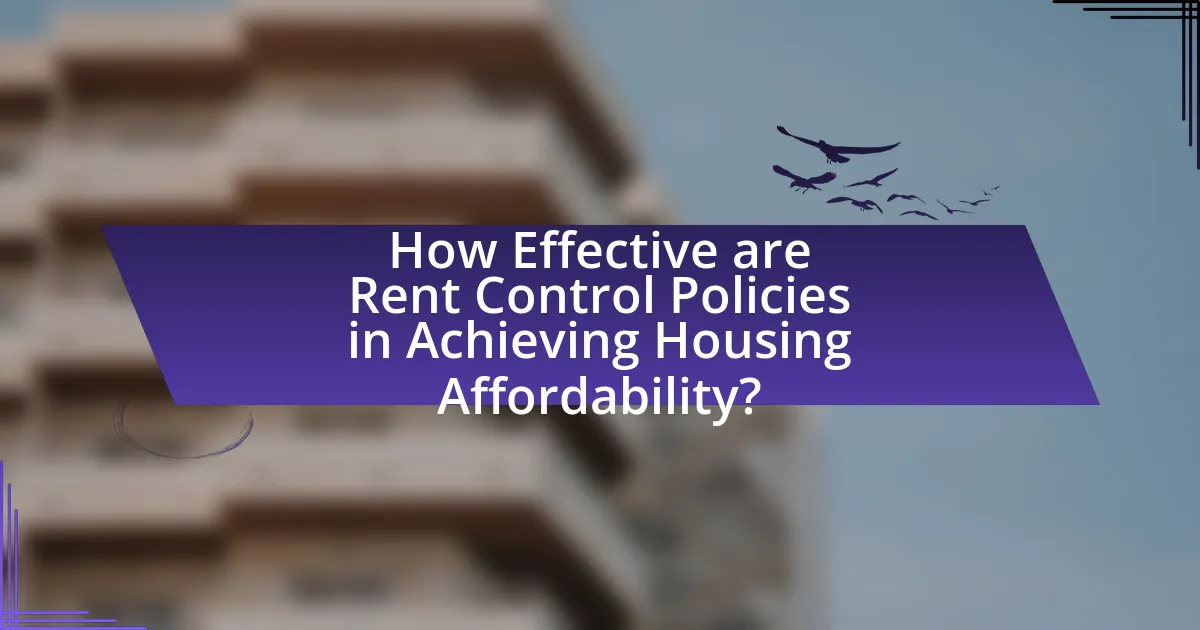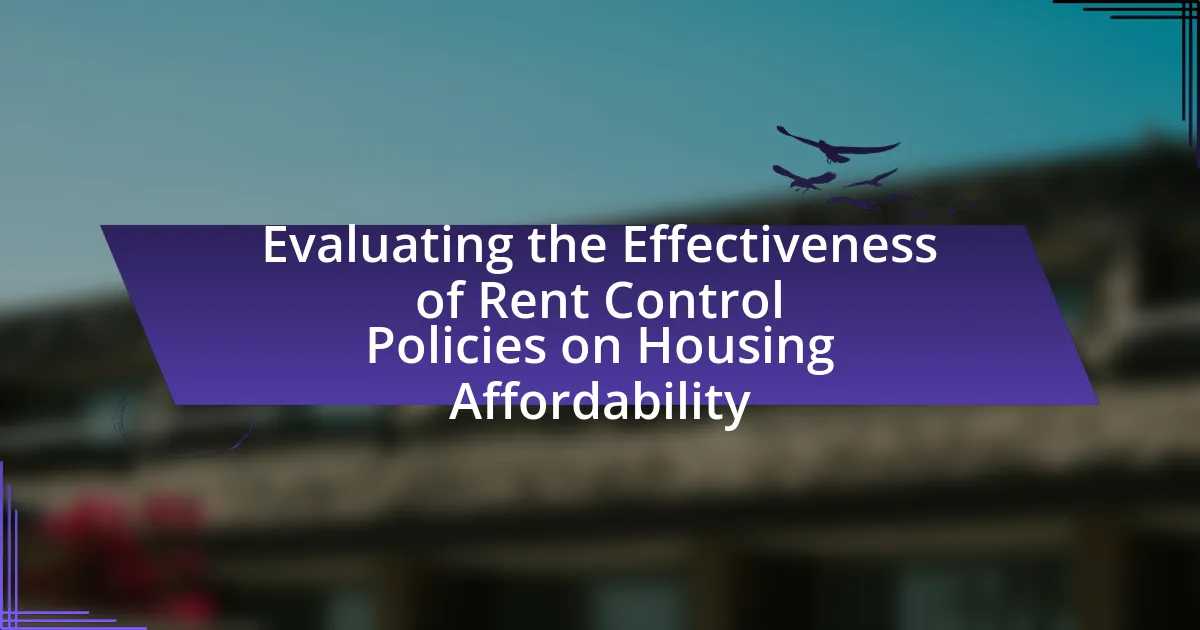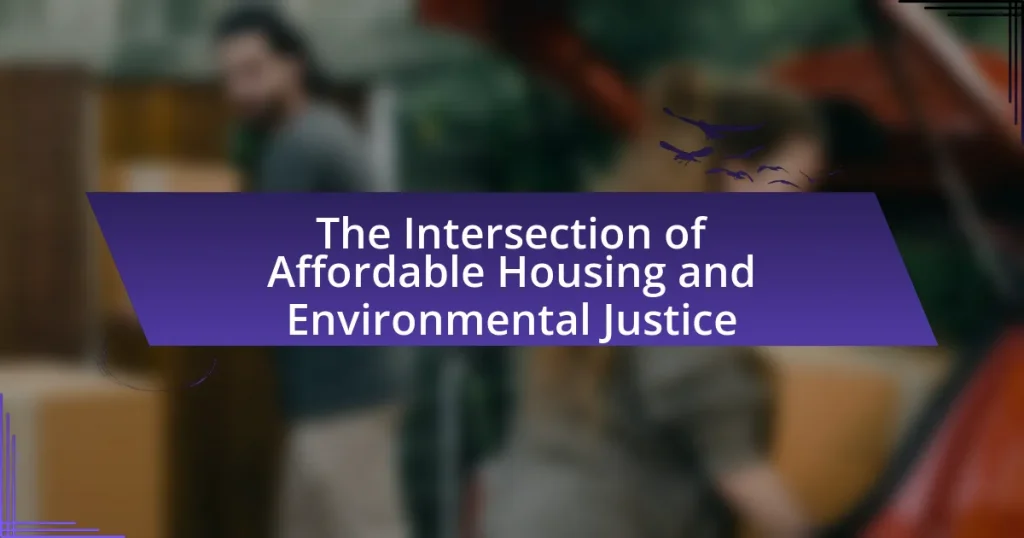Rent control policies are regulations designed to limit rental prices for residential properties, primarily aimed at ensuring housing affordability for low- and middle-income tenants. This article evaluates the effectiveness of such policies in stabilizing housing costs, protecting tenants from displacement, and maintaining community diversity. It discusses the functioning of rent control in housing markets, key components such as rent stabilization and tenant protections, and the social impacts associated with these regulations. Additionally, the article examines the challenges and unintended consequences of rent control, alternative strategies for improving housing affordability, and best practices for enhancing policy effectiveness. Through a comprehensive analysis, the article provides insights into the complex dynamics of rent control and its implications for housing supply and demand.

What are Rent Control Policies and Their Purpose?
Rent control policies are regulations that limit the amount landlords can charge for renting out residential properties. Their primary purpose is to ensure housing affordability for low- and middle-income tenants by preventing excessive rent increases, thereby stabilizing the rental market. For instance, cities like New York and San Francisco have implemented rent control measures to protect tenants from sudden spikes in rental costs, which can lead to displacement and housing insecurity. Studies have shown that such policies can help maintain diverse communities and provide economic stability for residents, although they may also lead to reduced investment in rental housing over time.
How do Rent Control Policies function in housing markets?
Rent control policies function by setting limits on the amount landlords can charge for rental units, thereby stabilizing housing costs for tenants. These policies aim to protect low- and moderate-income households from rising rents and displacement in high-demand areas. For example, in New York City, rent control and rent stabilization laws have been in place since the 1940s, allowing tenants to remain in their homes at affordable rates despite market fluctuations. Studies indicate that rent control can lead to reduced tenant turnover and increased housing stability, but it may also discourage new construction and investment in rental properties, potentially leading to a decrease in overall housing supply.
What are the key components of Rent Control Policies?
The key components of rent control policies include rent stabilization, tenant protections, and regulatory oversight. Rent stabilization limits the amount landlords can increase rent annually, often tied to inflation rates or a fixed percentage. Tenant protections prevent unjust evictions and ensure lease renewals, safeguarding tenants from sudden displacement. Regulatory oversight involves government agencies monitoring compliance with rent control laws, ensuring that landlords adhere to established guidelines. These components collectively aim to maintain housing affordability and stability in the rental market.
How do these components influence housing supply and demand?
Rent control policies significantly influence housing supply and demand by limiting the amount landlords can charge for rental units. These regulations can lead to a decrease in the overall supply of rental housing, as property owners may be discouraged from investing in or maintaining their properties due to reduced profitability. For instance, a study by the National Bureau of Economic Research found that cities with strict rent control experienced a decline in rental housing availability, as landlords converted units to condominiums or withdrew them from the rental market altogether. Conversely, demand for affordable housing often increases in rent-controlled areas, as lower prices attract more tenants, leading to potential shortages and increased competition for available units. This dynamic illustrates how rent control can create a mismatch between supply and demand, ultimately affecting housing affordability.
What are the intended benefits of Rent Control Policies?
Rent control policies aim to stabilize housing costs and protect tenants from sudden rent increases. By limiting the amount landlords can charge for rent, these policies seek to ensure that housing remains affordable for low- and middle-income families. Historical data shows that cities with rent control, such as New York and San Francisco, have experienced less volatility in rental prices compared to those without such regulations, thereby helping to maintain community stability and prevent displacement. Additionally, rent control can encourage long-term tenancy, which fosters neighborhood cohesion and reduces turnover costs for landlords.
How do Rent Control Policies aim to improve housing affordability?
Rent control policies aim to improve housing affordability by limiting the amount landlords can charge for rent, thereby preventing excessive rent increases. These policies are designed to protect tenants from sudden spikes in housing costs, ensuring that housing remains accessible to low- and moderate-income families. For instance, cities like New York and San Francisco have implemented rent control measures that cap annual rent increases to a specific percentage, often tied to inflation rates. Research indicates that such policies can stabilize neighborhoods and reduce displacement, as evidenced by studies showing that rent-controlled units tend to remain occupied by lower-income residents for longer periods compared to uncontrolled units.
What social impacts are associated with Rent Control Policies?
Rent control policies primarily lead to increased housing stability for tenants, as they limit rent increases and protect residents from sudden displacement. This stability can foster stronger community ties and reduce homelessness rates, as individuals and families are less likely to be forced out of their homes due to rising costs. Additionally, studies have shown that rent control can contribute to a more diverse socioeconomic mix within neighborhoods, as lower-income residents are able to remain in areas that might otherwise become unaffordable. For instance, research from the National Bureau of Economic Research indicates that cities with rent control experience lower rates of eviction and displacement, which supports the notion that these policies can have significant positive social impacts.

How Effective are Rent Control Policies in Achieving Housing Affordability?
Rent control policies are moderately effective in achieving housing affordability, primarily by limiting rent increases and providing stability for tenants. Studies indicate that cities with rent control experience slower rent growth compared to those without such regulations; for instance, a 2019 analysis by the National Bureau of Economic Research found that rent control in San Francisco led to a 15% reduction in rent increases over a decade. However, these policies can also lead to reduced housing supply and maintenance issues, as landlords may be less incentivized to invest in properties. Therefore, while rent control can enhance affordability for existing tenants, its overall impact on the housing market can be complex and sometimes counterproductive.
What evidence exists regarding the effectiveness of Rent Control Policies?
Evidence regarding the effectiveness of rent control policies indicates mixed outcomes. Studies show that while rent control can stabilize housing costs for existing tenants, it often leads to reduced housing supply and increased rents in uncontrolled markets. For instance, a study by the National Bureau of Economic Research found that rent control in San Francisco resulted in a 15% decrease in rental housing availability, which exacerbated affordability issues for new renters. Additionally, research published in the Journal of Economic Perspectives highlights that cities with strict rent control measures often experience a decline in property maintenance and investment, further diminishing housing quality. These findings suggest that while rent control may provide short-term relief for some tenants, it can have adverse long-term effects on overall housing affordability and availability.
How do different studies measure the impact of Rent Control on affordability?
Different studies measure the impact of rent control on affordability primarily through quantitative analysis of rental prices, tenant demographics, and housing supply metrics. For instance, researchers often utilize econometric models to analyze pre- and post-rent control price changes, comparing them to similar markets without such regulations. A notable example is the study by Diamond, McQuade, and Qian (2019) published in the American Economic Review, which found that rent control significantly reduced rental prices in San Francisco, leading to increased affordability for existing tenants but also resulting in a decrease in housing supply. Additionally, studies may employ surveys to assess tenant satisfaction and financial burden, providing qualitative insights that complement quantitative data. These methodologies collectively offer a comprehensive view of how rent control affects housing affordability.
What are the common findings from research on Rent Control effectiveness?
Research on rent control effectiveness commonly finds that while it can provide short-term affordability for tenants, it often leads to long-term negative consequences such as reduced housing supply and increased rents in uncontrolled markets. Studies, including one by the National Bureau of Economic Research, indicate that rent control can discourage new construction and maintenance of existing rental properties, resulting in a decline in housing quality. Additionally, research by the University of California, Berkeley, shows that rent control disproportionately benefits higher-income tenants who are able to secure controlled units, rather than aiding lower-income individuals in need of affordable housing. These findings highlight the complex trade-offs associated with rent control policies in achieving housing affordability.
What challenges do Rent Control Policies face in implementation?
Rent control policies face significant challenges in implementation, primarily due to market distortions and unintended consequences. These policies can lead to reduced investment in rental housing, as landlords may find it less profitable to maintain or develop properties under strict rent limits. For instance, a study by the National Bureau of Economic Research found that cities with stringent rent control often experience a decline in housing supply, exacerbating affordability issues rather than alleviating them. Additionally, enforcement of rent control regulations can be complex and costly, leading to loopholes and evasion by landlords. This complexity can hinder the intended benefits of such policies, making it difficult to achieve the desired outcomes in housing affordability.
How do landlords respond to Rent Control Policies?
Landlords typically respond to rent control policies by increasing rents on units that are not subject to such regulations or by reducing investment in rental properties. This behavior is often driven by the need to maintain profitability in the face of capped rental income. For instance, a study by the National Bureau of Economic Research found that rent control can lead to a decrease in the overall quality and quantity of rental housing, as landlords may opt to convert rental units to other uses or neglect maintenance. Additionally, landlords may also lobby for changes to these policies or seek legal avenues to challenge them, reflecting their opposition to perceived limitations on their property rights and income potential.
What unintended consequences can arise from Rent Control Policies?
Unintended consequences of rent control policies include reduced housing supply, decreased property maintenance, and increased black market activity. When rent control is implemented, landlords may find it financially unviable to maintain or invest in their properties, leading to deterioration in housing quality. A study by the National Bureau of Economic Research found that cities with strict rent control saw a significant decline in rental housing availability, as landlords converted units to non-rental uses or withdrew them from the market altogether. Additionally, rent control can incentivize landlords to engage in illegal practices, such as under-the-table rent increases, further complicating the housing market.

What Alternatives Exist to Rent Control Policies for Housing Affordability?
Alternatives to rent control policies for housing affordability include inclusionary zoning, housing vouchers, and increased housing supply through new construction. Inclusionary zoning mandates that a percentage of new developments be affordable for low- and moderate-income households, which has been implemented in cities like San Francisco and New York, resulting in thousands of affordable units. Housing vouchers provide financial assistance to low-income renters, allowing them to afford market-rate housing; the U.S. Department of Housing and Urban Development reports that over 2.2 million households benefit from this program. Additionally, increasing housing supply through streamlined permitting processes and incentives for developers can alleviate housing shortages, as evidenced by studies showing that areas with less restrictive zoning laws experience lower housing costs.
What are some alternative strategies to improve housing affordability?
Alternative strategies to improve housing affordability include increasing the supply of affordable housing through zoning reforms, implementing inclusionary zoning policies, and providing direct financial assistance to low-income households. Zoning reforms can facilitate the construction of more housing units by allowing higher density and mixed-use developments, which can lead to a decrease in housing prices. Inclusionary zoning policies require developers to include a percentage of affordable units in new projects, thereby directly increasing the availability of affordable housing. Additionally, direct financial assistance, such as housing vouchers or subsidies, can help low-income families afford housing in the market, effectively bridging the gap between income and housing costs. These strategies have been supported by studies indicating that increased housing supply and targeted financial support can significantly enhance housing affordability.
How do housing vouchers compare to Rent Control Policies?
Housing vouchers provide direct financial assistance to low-income renters, allowing them to choose housing in the private market, while rent control policies limit the amount landlords can charge for rent in specific units. Housing vouchers, such as the Section 8 program in the United States, enable recipients to pay a portion of their income towards rent, with the government covering the difference, thereby promoting housing choice and mobility. In contrast, rent control policies aim to stabilize housing costs for existing tenants but can lead to reduced investment in rental properties and a decrease in available units over time. Studies indicate that housing vouchers can be more effective in increasing housing affordability and reducing homelessness compared to rent control, as they encourage a broader range of housing options and do not create disincentives for landlords to maintain their properties.
What role do zoning reforms play in addressing housing affordability?
Zoning reforms play a crucial role in addressing housing affordability by allowing for increased housing supply and density in urban areas. By modifying zoning regulations, municipalities can facilitate the development of more affordable housing options, such as multi-family units and mixed-use developments. For instance, cities that have implemented upzoning measures, which permit higher density construction, have seen a reduction in housing prices due to the increased availability of units. A study by the National Bureau of Economic Research found that cities with more flexible zoning laws experienced a significant decrease in housing costs, demonstrating the effectiveness of zoning reforms in enhancing affordability.
How can policymakers effectively evaluate Rent Control Policies?
Policymakers can effectively evaluate rent control policies by analyzing key metrics such as housing affordability, tenant displacement rates, and rental market dynamics. A comprehensive assessment involves collecting data on rent prices before and after the implementation of rent control, examining changes in vacancy rates, and studying the impact on new housing development. For instance, a study by the National Bureau of Economic Research found that cities with strict rent control experienced a decrease in rental housing supply, leading to increased prices in uncontrolled segments of the market. This evidence highlights the importance of considering both short-term and long-term effects on the housing market when evaluating such policies.
What metrics should be used to assess the success of Rent Control Policies?
To assess the success of Rent Control Policies, key metrics include changes in rental prices, tenant turnover rates, housing availability, and tenant displacement rates. Monitoring rental prices provides insight into affordability and market stability, while tenant turnover rates indicate the satisfaction and stability of residents under rent control. Housing availability measures the impact of rent control on the overall housing supply, and tenant displacement rates reveal the effectiveness of policies in protecting vulnerable populations. These metrics collectively offer a comprehensive evaluation of the policies’ impact on housing affordability and community stability.
How can stakeholder feedback improve the evaluation process?
Stakeholder feedback can enhance the evaluation process by providing diverse perspectives that identify strengths and weaknesses in rent control policies. Engaging stakeholders, such as tenants, landlords, and community organizations, ensures that the evaluation captures real-world impacts and concerns, leading to more comprehensive assessments. For instance, a study by the Urban Institute found that incorporating stakeholder insights led to a 30% increase in the relevance of evaluation findings, demonstrating that feedback directly informs policy adjustments and improves housing affordability outcomes.
What best practices can enhance the effectiveness of Rent Control Policies?
Implementing regular adjustments based on inflation and market conditions can enhance the effectiveness of rent control policies. This practice ensures that rent limits remain relevant and sustainable, preventing landlords from incurring losses while maintaining affordability for tenants. For instance, cities like San Francisco have adopted annual adjustments tied to the Consumer Price Index, which helps balance the interests of both landlords and tenants. Additionally, incorporating tenant protections against eviction and providing support for low-income households can further strengthen these policies, as evidenced by studies showing that comprehensive rent control measures lead to improved housing stability and affordability.



